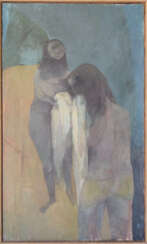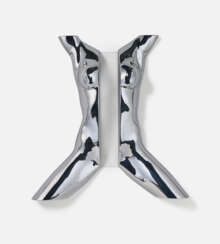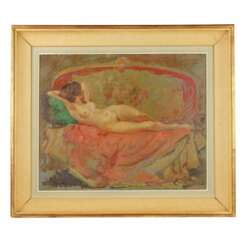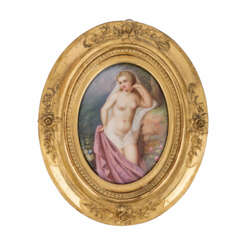nude male



Alexander Vasilyevich Kuprin (Russian: Алекса́ндр Васи́льевич Купри́н) was a Russian painter and educator, renowned for his contribution to the "Jack of Diamonds" group and his profound influence on Soviet art. Born in Borisoglebsk, Voronezh region, in 1880, Kuprin's early life was steeped in the creative atmosphere provided by his family, moving to Voronezh in 1893. His educational journey through various art schools culminated at the Moscow School of Painting, Sculpture, and Architecture, where he was under the tutelage of Abram Arkhipov and Konstantin Korovin.
Kuprin's art evolved significantly over time. Initially inspired by French painting and Cézanne, his early works were marked by Cubist influences, characterized by a geometric simplification of forms. As one of the founding members of the Knave of Diamonds, he was at the forefront of avant-garde movements in Russia. However, his style underwent a transformation towards realism in the 1920s, influenced by his experiences in Nizhny Novgorod and later travels to Crimea. This period marked a departure from avant-garde to a focus on industrial landscapes and the natural beauty of the Crimean peninsula.
His significant works, often reflecting his fascination with the interplay of light, shadow, and form, are held in high esteem, with notable pieces like "Still Life With Blue Tray" and "The Beasal’skaia Valley" housed in the Tret’iakov Gallery. Kuprin's commitment to education saw him teaching at various institutions, including the Moscow textile Institute and the Moscow Higher Art and Industrial School, influencing generations of artists.
Alexander Vasilyevich Kuprin's legacy is not only in the beauty he captured on canvas but also in the minds he shaped through his teaching. His works, a testament to the evolution of Russian art through turbulent times, continue to inspire and captivate.
Collectors and experts in art and antiques can find a deeper appreciation for Kuprin's work by exploring his contributions to the Russian avant-garde and his influence on Soviet art aesthetics. For those interested in staying updated on sales and auction events related to Alexander Vasilyevich Kuprin, signing up for updates is highly recommended. This subscription will provide exclusive insights into the availability of his works, ensuring enthusiasts don't miss the opportunity to own a piece of Russian art history.


Nicola Samori is an Italian painter-painter and sculptor known for his brutal manipulation of works of art.
He graduated from the Academy of Fine Arts in Bologna and lives and works in Bagnacavallo.
Samori's work is inspired by the works of great masters, more often in the Baroque style of the 16th and 17th centuries: he creates copies of them and then rips, scratches, pierces them, thereby transforming them, filling them with the restless spirit of our time. In roughly the same way, the artist also creates sculptural works, giving birth to new, modern images rooted in the history of art.


George Grosz was a twentieth-century German painter, graphic artist, and cartoonist. In his work one can find features of various styles of avant-garde art, including Dadaism, Expressionism, and Futurism.
George Grosz drew in every style in a sharp-grotesque and satirical spirit, ridiculing the vices of society. The erotic theme, which occupied a prominent place in Gross's work, was executed in the same spirit.
Grosz devoted more than 20 years to teaching at the Art Students League of New York, and was elected an honorary member of the American and Berlin Academies for his outstanding services to the arts.


George Grosz was a twentieth-century German painter, graphic artist, and cartoonist. In his work one can find features of various styles of avant-garde art, including Dadaism, Expressionism, and Futurism.
George Grosz drew in every style in a sharp-grotesque and satirical spirit, ridiculing the vices of society. The erotic theme, which occupied a prominent place in Gross's work, was executed in the same spirit.
Grosz devoted more than 20 years to teaching at the Art Students League of New York, and was elected an honorary member of the American and Berlin Academies for his outstanding services to the arts.




Max Schwimmer is a German painter, graphic artist, and illustrator, a member of the Academy of Arts in Berlin.


Wolfgang Tillmans is a German photographer. His diverse body of work is distinguished by observation of his surroundings and an ongoing investigation of the photographic medium’s foundations.
Tillmans was the first photographer – and also the first non-British person – to be awarded the Tate annual Turner Prize. He has also been awarded the Hasselblad Award, the Royal Photographic Society's Centenary Medal, the Royal Academy Summer Exhibition's Charles Wollaston Award, The Culture Prize of the German Society for Photography, and is an Academician of the Royal Academy of Arts, London.

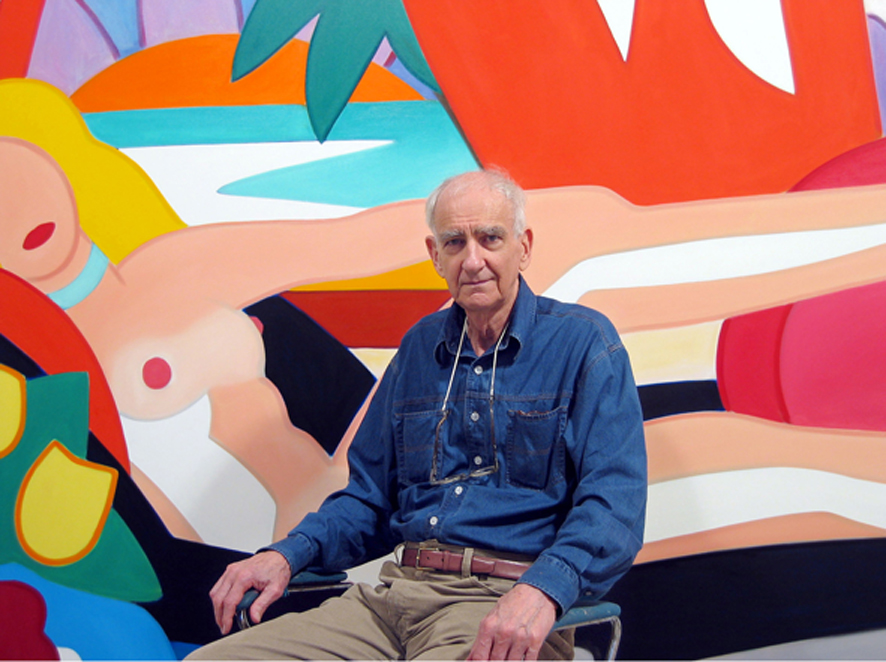
Tom Wesselmann was an American artist associated with the Pop Art movement who worked in painting, collage and sculpture.
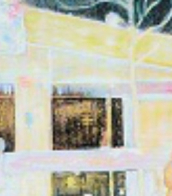

George Grosz was a twentieth-century German painter, graphic artist, and cartoonist. In his work one can find features of various styles of avant-garde art, including Dadaism, Expressionism, and Futurism.
George Grosz drew in every style in a sharp-grotesque and satirical spirit, ridiculing the vices of society. The erotic theme, which occupied a prominent place in Gross's work, was executed in the same spirit.
Grosz devoted more than 20 years to teaching at the Art Students League of New York, and was elected an honorary member of the American and Berlin Academies for his outstanding services to the arts.


George Grosz was a twentieth-century German painter, graphic artist, and cartoonist. In his work one can find features of various styles of avant-garde art, including Dadaism, Expressionism, and Futurism.
George Grosz drew in every style in a sharp-grotesque and satirical spirit, ridiculing the vices of society. The erotic theme, which occupied a prominent place in Gross's work, was executed in the same spirit.
Grosz devoted more than 20 years to teaching at the Art Students League of New York, and was elected an honorary member of the American and Berlin Academies for his outstanding services to the arts.


Dmitry Mikhailovich Krasnopevtsev (Russian: Дмитрий Михайлович Краснопевцев) was a Soviet and Russian artist of the second half of the twentieth century. He is known as a painter and graphic artist, a representative of "unofficial art" and the so-called Second Russian avant-garde.
Dmitry Krasnopevtsev chose as his main genre "metaphysical still lifes" approaching surrealism, often depicting ceramics, dried plants and shells in melancholy colors. These works developed Baroque motifs of the frailty and unreality of the world. Although for a long time his works were little exhibited in his homeland, they found admirers in other countries such as Austria, Germany, France, Japan, and the United States.


Henry Fuseli (German: Johann Heinrich Füssli) was a Swiss painter, draughtsman and writer on art who spent much of his life in Britain. Many of his works, such as The Nightmare, deal with supernatural subject matter. He painted works for John Boydell's Shakespeare Gallery, and created his own "Milton Gallery". He held the posts of Professor of Painting and Keeper at the Royal Academy. His style had a considerable influence on many younger British artists, including William Blake.









